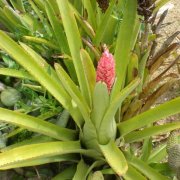Care of the indoor plant Quesnelia arvensis or Ananas arvensis |
|
The genus Quesnelia, family Bromeliaceae, comprises 18 species of bromeliads native to Brazil. Some species are: Quesnelia arvensis, Quesnelia testudo, Quesnelia seideliana, Quesnelia humilis. Scientific synonym: Ananas arvensis. This species is native to Brazil. They are evergreen terrestrial bromeliads that reach 60 cm (23.6") in height. The lanceolate leaves have small dark spines on the edge, are green on the upper side and have silver lines on the underside. The flowers appear on a white floral stem that ends in a pink inflorescence with small blue petals. They bloom from late summer to early fall. Ananas arvensis is used as indoor or greenhouse plants; In tropical and subtropical climates it's used in clear forests of coastal gardens. Quesnelia arvensis can grow in semi-shade or full sun exposure but with high humidity. It's a tropical plant that does not resist temperatures below 8 ºC (46.4 ºF). The soil can be a light garden substrate with coarse sand and organic matter. Water moderately with lime-free water, waiting for the substrate to dry. To achieve a medium-high humidity, spray the leaves in the summer at sunset from time to time. Fertilize every 3 weeks with mineral houseplant fertilizer during the summer. Quesnelia arvensis does not need pruning; Outdoors, its expansion must be monitored because it can become invasive. Ananas arvensis is a plant quite resistant to pests and diseases; It can be attacked by mites and aphids if the humidity is low. Quesnelia arvensis is propagated by division in early spring. |
Images of the indoor plant Quesnelia arvensis or Ananas arvensis |
Find plants
Quesnelia arvensis or Ananas arvensis | Care and Growing
© 2025 FavThemes

